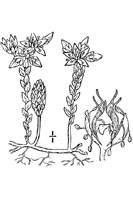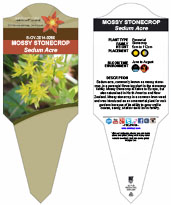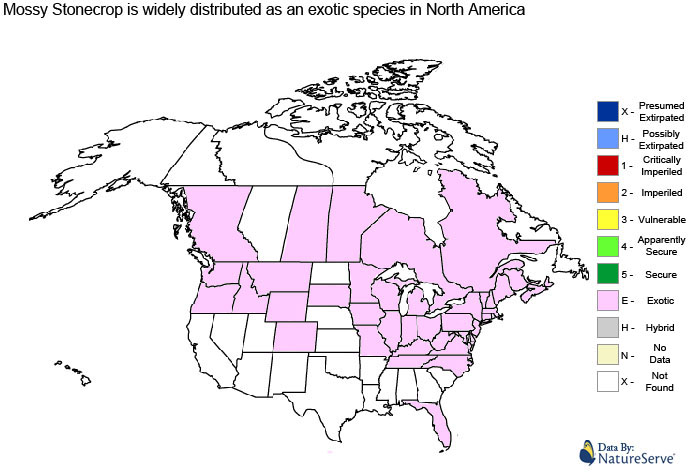Sedum acre, commonly known as stringy stonecrop, is a perennial flowering plant in the stonecrop family. Stringy Stonecrop is native to Europe, but also naturalized in North America and New Zealand. Stringy stonecrop is a common lawn weed and was introduced as an ornamental plant for rock gardens because of its ability to grow well in coarse, sandy, shallow soils low in fertility. In these situations, it can crowd out grass and become a serious lawn weed. The genus name sedum come from the latin word 'succulent'.The species mean acre means 'acrid' or 'bitter tasting.' This name can be traced to the bitter, often unpalatable, taste of the plant.
Stringy Stonecrop is used in hanging baskets and container gardens, as a trailing accent, in borders, or as groundcover.

Within the realm of naturopathic medicine and folklore, stringy stonecrop can be used as an astringent, hypotensive, laxative, rubefacient, vermifuge and vulnerary herb. Stringy Stonecrop is considered to be a useful medicinal plant by some herbalists, though others do not use it because of the violence of its operation when taken internally. One of its best uses is as an effective and harmless corn-remover, it can also be used to bring boils to a head, though this can also cause some local irritation. The bruised fresh plant is applied as a poultice to wounds and minor burns, though some care should be exercised because the plant can cause blisters or skin irritations. The herb is difficult to dry and so is best used when fresh, it can be gathered at any time during the spring and summer. A homeopathic remedy is made from the plant. It is used in the treatment of piles and anal irritations.
Please note that MIROFOSS does not suggest in any way that plants should be used in place of proper medical and psychological care. This information is provided here as a reference only.
Stringy Stonecrop is rich in vitamin C, but it has a bitter acrid taste. The main interest in the edible qualities of this plant is as a survival food, since it grows wild in the driest deserts as well as in arctic conditions. Large quantities of stringy stonecrop can cause stomach upsets and other adverse effects. When stringy stonecrop is consumed, the leaves are dried and ground into a powder to make a spicy seasoning with a peppery taste.
Stringy Stonecrop is a low-growing plant that cannot compete with more vigorous, fast-growing species. It is specially adapted for growing on thin dry soils and can be found on shingle roofs, beaches, dry stone walls, dry banks, seashore rocks, roadside verges, wasteland and in sandy meadows near the sea. Stringy Stonecrop can live under a variety of light levels. However, it does not thrive in dense shade with limited water. Suitable for: light (sandy), medium (loamy) and heavy (clay) soils, prefers well-drained soil and can grow in nutritionally poor soil. Suitable pH: acid, neutral and basic (alkaline) soils.
| Soil Conditions |
   |
| Soil Moisture |
   |
| Sunlight |
  |
| Notes: |
  |
Stringy stonecrop is a tufted perennial herb that forms mat-like stands some 5cm to 12cm tall. Much of the year the stems are short, semi prostrate and densely clad in leaves. At the flowering time in June and July, the stems lengthen and are erect, somewhat limp and often pinkish-brown with the leaves further apart. The leaves are alternate, fleshy and shortly cylindrical with a rounded tip. They are also sometimes tinged with red. The starry flowers form a three to six-flowered cyme. The calyx has five fleshy sepals fused at the base, the corolla consists of five regular bright yellow petals, there are ten stamens, a separate gynoecium and five pistils. The fruit is five united, many-seeded follicles. The flowers are hermaphrodite (have both male and female organs) and are pollinated by bees, flies, and itself. The plant is self-fertile.
| Plant Height |
5cm to 12cm |
| Habitat |
Disturbed Areas, Roadsides, open woods |
| Leaves |
2mm to 6mm long, smooth and fleshy |
|
| Leaf Margin |
Entire |
| Leaf Venation |
Longitudinal |
| Stems |
mat-like strands |
| Flowering Season |
June to August |
| Flower Type |
Rounded clusters of flowers 10mm wide with short petals |
| Flower Colour |
yellow |
| Pollination |
Insects and self |
| Flower Gender |
Flowers are hermaphrodite and the plants are self-fertile |
| Fruit |
Follicles 3mm to 10mm long in clusters of 5. |
| USDA Zone |
4A (-31.7°C to -34.4°C) cold weather limit |
The following health hazards should be noted when handling or choosing a location to plant stringy stonecrop:
 |
SKIN IRRITANT
The sap can irritate the skin of some people and cause rashes.
|
 |
-Click here- or on the thumbnail image to see an artist rendering, from The United States Department of Agriculture, of stringy stonecrop. (This image will open in a new browser tab) |
 |
There is currently no seed image(s) available for stringy stonecrop. |
Stringy Stonecrop can be referenced in certain current and historical texts under the following seven names:
Stringy Stonecrop can be translated into the following select languages:
| Arabic |
السيدوم |
Bulgarian |
|
Chinese (Sim) |
景天 |
| Croatian |
|
Czech |
rozchodník |
Danish |
stenurt |
| Dutch |
muurpeper |
Esperanto |
|
Estonian |
|
| Finnish |
|
French |
orpin |
German |
Mauerpfeffer |
| Greek |
|
Hebrew |
|
Hungarian |
|
| Italian |
|
Japanese |
弁慶草 |
Korean |
|
| Low Saxon |
|
Lithuanian |
|
Norwegian |
bergknapp |
| Persian |
|
Polish |
rozchodnika |
Portuguese |
|
| Romanian |
|
Russian |
очиток |
Slovak |
rozchodník |
| Spanish |
uva de gato |
Swedish |
fetknopp |
Tagalog |
|
| Turkish |
|
Ukrainian |
очиток |
Vietnamese |
|
| The information provided in this conservation assessment has been provided by the Natureserve Database in conjuction with various federal, provincial, state, county, district, regional, and municipal governments as well as public and private conservation authorities. Information in this section is accurate from the last time this article was updated. |
 |
Stringy Stonecrop has no conservation status as it is considered an exotic and or invasive species in North America. |
 |
The MIROFOSS database offers free printable garden tags for personal and non-profit use. These tags can be used to properly identify plant samples in a garden. Click on the tags shown on the the screen or -click here- to download a full size jpeg image for a stringy stonecrop identification tag; which can be printed on paper or used with a plastic laser printer. |
 |
What's this?
This is a QR code (short for Quick Response) which gives fast-track access to MIROFOSS articles. QR Codes are barcodes that can be read by smart phone cameras. This QR Code is unique to this MIROFOSS article.
What can I do with it?
You can copy and print the QR code to a plant label, poster, book, web site, magazines, or newspaper so smart phone users can scan the QR Code which automatically takes them to this specific article.
|
| Background |
Dickinson, R.; Royer, F.; (2014) Plants of Southern Ontario. ISBN 978-1-55105-906-8 |
| Biology |
Dickinson, T.; Metsger, D.; Bull, J.; & Dickinson, R. (2004) ROM Field Guide to Wildflowers of Ontario. Toronto:Royal Ontario Museum, p. 243. |
| Image Rendering |
USDA-NRCS PLANTS Database / USDA NRCS. Wetland flora: Field office illustrated guide to plant species. USDA Natural Resources Conservation Service. |
| Environment |
National Audubon Society. Field Guide To Wildflowers (Eastern Region): Alfred A. Knopf. pp 415-420 ISBN 0-375-40232-2 |
| Physical Identification |
National Audubon Society. Field Guide To Wildflowers (Eastern Region): Alfred A. Knopf. pp 415-420 ISBN 0-375-40232-2 |
| April 15, 2015 |
The last time this page was updated |
| ©2021 MIROFOSS™ Foundation |
|




















